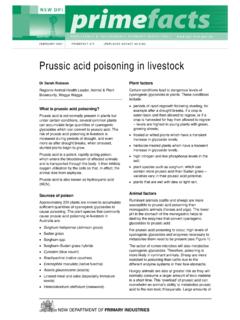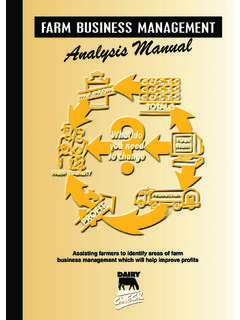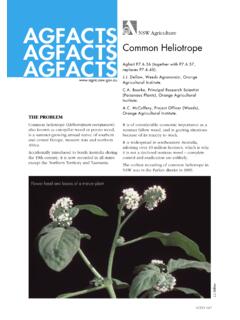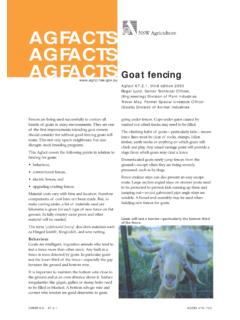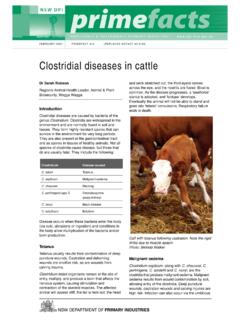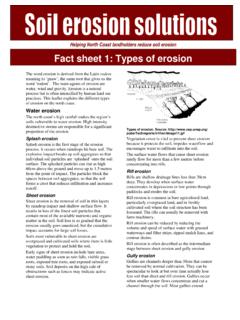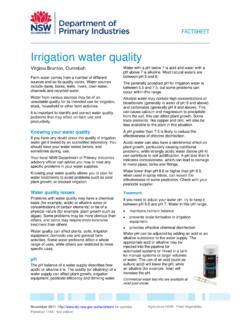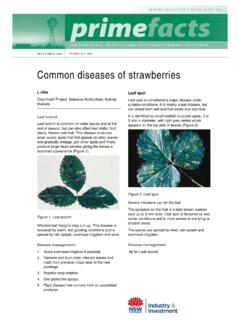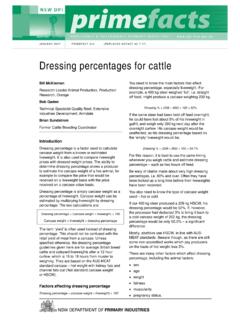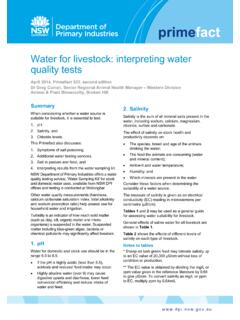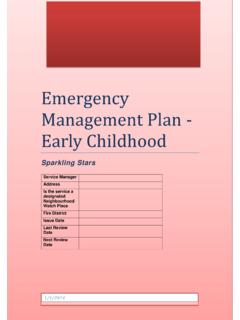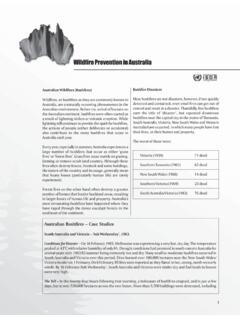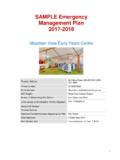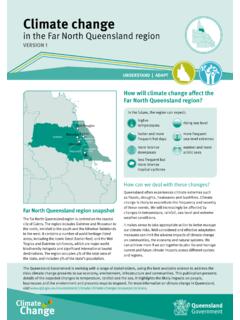Transcription of Introduction to commercial duck farming
1 FACTSHEET June 2012, for updates Primefact 1235 first edition Introduction to commercial duck farming Byron Stein, Livestock Officer (Poultry), Goulburn This Primefact has been produced for prospective farmers, investors and those interested in the commercial duck meat industry. It provides an overview of: the duck industry; current production features; financial issues and critical planning and development considerations. This includes managing risks to bird welfare, the environment and biosecurity. Introduction commercial duck meat farms are intensive operations similar to chicken meat farms. Ducks are raised in sheds which vary from open-sided naturally ventilated sheds to fully enclosed climate controlled tunnel ventilated houses. commercial duck meat production is therefore a full-time specialised business requiring significant investment in both time and money. Whilst the duck meat industry is quite small in comparison to chicken meat production, it is expanding rapidly at a growth rate of 10-15% annually.
2 The Australian industry processes 8 million birds annually and is worth an estimated $100 This growth, together with increasing domestic and global demand makes duck meat farming an attractive option for those considering entry into this industry. Breeds used for meat production The major breeds available for meat production in Australia are Pekin, Muscovy, Aylesbury and Rouen and crosses of these breeds. The Pekin duck (Anas Domesticus) is the predominant breed used for meat production in Australia. commercial 1 commercial duck Production for Bird Welfare, Environmental Benefits and Efficiency, RIRDC 2010 strains of Pekin duck are bred in the United Kingdom and France. Figure 1, Pekin ducks are the most popular breed for commercial meat and egg production. Photo: NSW DPI Did you know? Pekin duck is often confused with Peking duck . Pekin duck is a breed of duck whereas Peking duck is a famous duck dish from Beijing that has been prepared since the imperial era, and is considered one of China's national foods.
3 Size of commercial duck farms The size of commercial farms is typically measured by the number of birds reared at any one time. commercial operations vary in size from relatively small farms of 6,000 ducks per batch to large operations with 50,000 to 100,000 ducks per batch. Most current commercial duck farms house between 10,000 to 50,000 birds at a time. Primary Industries Critical issues when considering commercial duck farming 1. Development Costs Similar to chicken meat operations, the capital investment and development costs for duck farming depends on a range of factors, including: Land prices; Size of the enterprise. This is determined by the number, size and type of sheds (open sided and naturally ventilated or fully enclosed tunnel ventilated sheds); Existing infrastructure and services (electricity, gas, water and road/transport services) and any upgrade costs; Local council development application requirements.
4 The costs of assessing the potential environmental impacts and preparing a development application will depend on the scale of the operation and the level of constraints for the proposed site. For instance on a relatively large rural property there may be no need to conduct detailed noise assessments; Environmental engineering costs associated with constructing the sheds, providing access for trucks, a water supply and other infrastructure. For instance the amount of cut and fill required to level the shed site will be more expensive on a sloping site. For these reasons it is difficult to provide an accurate indication of enterprise establishment costs. If no major site constraints occur and depending on the size of the enterprise it may require an investment of 2 to million dollars. The potential income will also vary depending on the size of the operation, the contract price negotiated with the processor and the number of batches reared per year.
5 A typical family run duck farming enterprise, housing 10 - 50,000 birds would produce a total of 60 - 300,000 birds a year over 6 batches. 2. Seek expert legal, financial and business advice It is essential to complete a feasibility study to determine if the enterprise is for you. In most instances, duck meat farmers operate under a contract to a processing company. The contract will usually stipulate the price per kg/liveweight of the birds, the contract term and conditions under which the birds must be raised. Legal opinion on contract security is advisable to assure that the payback period for the investment is possible. Upfront capital costs may exceed several million dollars. A financial adviser should be consulted to assist in predicting a pay back period for the investment. It s also advisable to develop an Environmental Management plan and Biosecurity plan for the enterprise to support your development application.
6 This ensures upfront that you can manage the range of potential risks and issues associated with the development. 3. Planning the development commercial duck farming is usually considered an Intensive Livestock Agricultural Enterprise. Hence you will be required to prepare and submit a Development Application (DA) to your local council for approval to establish, expand or modify a commercial duck meat enterprise. Before beginning a plan : Familiarise yourself with industry guidelines Contact your local council to identify areas suitable for intensive agricultural developments and to confirm that a DA is required and what needs to be addressed in the DA This includes identifying what provisions of the Local Environmental Plans and State Environmental Planning Policies apply. What level of environmental assessment is required? What the key issues are? How long will it take to obtain approval? What are the indicative costs of lodging a Development Application?
7 Consider how your development will affect the environment and neighbours and what measures you will take to minimise these impacts Find out if other legislation affects your proposed development and what other permits or licences are required? For instance do you need to clear native vegetation or remnant trees, or do you need permits to access water? It is necessary to check if changing the design or location might avoid such additional requirements It is highly advisable to engage the services of a suitably qualified and experienced consultant. A well- prepared application will save both time and money and will reduce the risk of conflict and objections from both council and the community. For comprehensive information on preparing development applications refer to the following publications: p 2 Introduction to commercial duck farming o Preparing a development application for intensive agriculture in NSW available at o Best Practice Management for Meat Chicken Production in NSW (Manual 1 Site Selection and Development) available at Whilst most of the publications referenced in this factsheet refer to chicken meat enterprises, the principles associated with potential environmental impacts and management options are relevant to the duck meat industry.
8 4. Siting and design considerations The establishment of a duck meat farm is a substantial long-term investment, making it critical to ensure that an appropriate development locality and site is chosen. Appropriate siting is the most cost-effective way of dealing with environmental performance issues such as odour, dust, noise and protection of waters. By addressing these issues at the planning stage, ongoing operational costs and management issues will be significantly reduced. Critical issues to consider include: Locality proximity to processing plants, feed mills, clean litter supplies, labour and services; Size the property must be of sufficient size to accommodate all the facilities required to support the planned operation. Also consider possible future expansion needs; Odour, dust and noise impacts addressing such impacts are the most common challenges faced by commercial duck meat farmers. The property should be large enough to provide for adequate setbacks (buffer distances) to minimise the likelihood of offensive odour, dust and noise impacts on neighbouring properties; Biosecurity particularly separation distances from other poultry enterprises to prevent the spread of disease; Available suitable water supplies, for bird drinking needs, cleaning the sheds and for fighting bushfires if relevant; Site constraints such as topography, water flows, native vegetation and bushfire hazard risk reduction requirements; and Service corridors and supply including: 3-phase power, water pipelines and storage, and road access for the size and type of vehicles involved.
9 For comprehensive information on siting and design considerations refer to the following publications: Best Practice Management for Meat Chicken Production in NSW (Manual 1 Site Selection and Development) Better Site Selection for Meat Poultry Developments Copies of these publications are available from NSW DPI and are also available at 5. Managing environmental impacts Most intensive agricultural enterprises are associated with potential environmental impacts. For duck farming potential environmental impacts are commonly associated with: air quality (odour & dust) noise catchment protection (eg nutrient run off, erosion or storm water flows) disposal of litter disposal of dead birds Development Applications will be required to demonstrate how these impacts will be managed to comply with minimum acceptable limits. A range of publications and guides are available to plan and manage environmental.
10 These include: National Environmental Management System for the Meat Chicken Industry Best Practice Management for Meat Chicken Production in NSW (Manual 1 Site Selection and Development) Odour Management Options for Meat Chicken Farms Better Site Selection for Meat Poultry Developments Refer to the resources section at the end of this factsheet for information on where to find these publications. 6. Animal Welfare There are no mandatory skills required as a pre-requisite for farming ducks. However, animal welfare is a critical component. Good stockmanship and an affinity for livestock will provide both productivity and animal welfare outcomes. Stockmanship is a concept of handling and operating around livestock that produces calm and highly responsive animals and does not produce long lasting anxiety, stress, or panic. Introduction to commercial duck farming p 3 Typical livestock nurturing duties include the following: providing fresh litter in sheds and removing spent litter; providing feed and water; monitoring shed temperature and humidity; monitoring feed consumption and growth rates; capturing and handling birds with confidence and patience; washing down equipment and maintaining hygiene standards; cleaning sheds after the removal of birds by mechanical or manual means; collecting, counting and recording mortalities; monitoring health and welfare; and working weekends and long hours Prospective duck farmers should also be aware of the Model Code of Practice for the Welfare of Animals (Domestic Poultry, 4th edition) which is a set of guidelines outlining minimum animal welfare standards and obligations in NSW.
